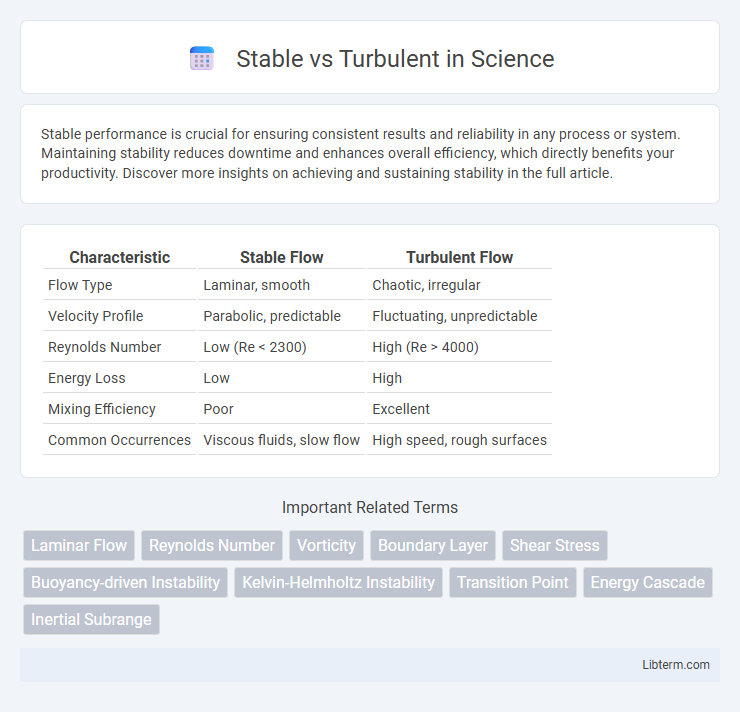Stable performance is crucial for ensuring consistent results and reliability in any process or system. Maintaining stability reduces downtime and enhances overall efficiency, which directly benefits your productivity. Discover more insights on achieving and sustaining stability in the full article.
Table of Comparison
| Characteristic | Stable Flow | Turbulent Flow |
|---|---|---|
| Flow Type | Laminar, smooth | Chaotic, irregular |
| Velocity Profile | Parabolic, predictable | Fluctuating, unpredictable |
| Reynolds Number | Low (Re < 2300) | High (Re > 4000) |
| Energy Loss | Low | High |
| Mixing Efficiency | Poor | Excellent |
| Common Occurrences | Viscous fluids, slow flow | High speed, rough surfaces |
Understanding Stability and Turbulence
Understanding stability and turbulence involves analyzing fluid flow patterns and their predictability. Stable flow maintains a consistent velocity and direction, characterized by laminar motion with minimal fluctuations, while turbulent flow exhibits chaotic changes in pressure and velocity, leading to irregular and unpredictable fluid behavior. Accurate prediction of these states is essential for optimizing aerodynamic performance, weather forecasting, and industrial fluid dynamics.
Defining Stable vs Turbulent Systems
Stable systems maintain consistent behavior over time, resisting external disturbances and returning to equilibrium after fluctuations. Turbulent systems exhibit chaotic, unpredictable patterns with rapid changes in flow or state, characterized by irregular velocity and pressure variations. Understanding the differences in energy dissipation and flow dynamics is essential for analyzing fluid mechanics, meteorology, and engineering applications.
Key Differences: Stability vs Turbulence
Stable flow features smooth, consistent motion with uniform velocity and minimal fluctuations, resulting in predictable fluid behavior. Turbulent flow is characterized by chaotic, irregular fluctuations, high mixing rates, and energy dissipation, leading to complex velocity fields. The Reynolds number serves as a critical parameter, with low values indicating stable flow and high values representing turbulent conditions.
Causes of Stability and Turbulence
Stable atmospheric conditions arise from strong temperature inversions, low surface heating, and weak wind shear, which suppress vertical air movement and limit turbulence. Turbulence is typically caused by intense surface heating, strong wind shear, obstacles like mountains or buildings disrupting airflow, and frontal systems creating instability. Understanding these factors is crucial for predicting weather patterns and ensuring aviation safety through turbulence forecasting.
Effects on Natural and Engineered Environments
Stable atmospheric conditions lead to limited air mixing, resulting in the accumulation of pollutants near the ground, which negatively affects air quality in urban and industrial areas. Turbulent conditions enhance dispersion and dilution of pollutants, promoting healthier natural ecosystems and reducing the risk of localized contamination in engineered environments such as chemical plants or ventilation systems. Understanding the balance between stability and turbulence is critical for designing effective environmental control measures and urban planning.
Stability and Turbulence in Fluid Dynamics
Stability in fluid dynamics refers to the fluid's ability to maintain smooth, orderly motion, characterized by laminar flow where velocity and pressure remain consistent over time. Turbulence occurs when perturbations grow, causing chaotic, irregular fluid behavior with vortices, eddies, and rapid fluctuations in velocity and pressure. The Reynolds number is a critical dimensionless parameter used to predict the transition from stable laminar flow to unstable turbulent flow based on fluid velocity, viscosity, and characteristic length.
Economic Stability vs Turbulent Markets
Economic stability ensures consistent growth, low inflation, and steady employment, fostering investor confidence and sustainable development. Turbulent markets are characterized by high volatility, unpredictable price swings, and increased risk, leading to uncertainty for businesses and consumers. Central banks and policymakers play a crucial role in mitigating turbulence through monetary policies and regulatory frameworks.
Strategies for Managing Turbulence
Effective strategies for managing turbulence in dynamic environments include implementing agile decision-making frameworks and fostering resilient organizational cultures. Emphasizing continuous monitoring of market trends and rapid adaptation to change enhances stability during turbulent periods. Leveraging scenario planning and robust risk management tools also mitigates the impact of unforeseen disruptions.
Real-World Examples: Stability vs Turbulence
Stable systems like deep ocean currents create reliable climate patterns, ensuring consistent weather conditions over decades. Turbulent systems, such as atmospheric storms or financial markets, exhibit rapid, chaotic changes that disrupt predictability and cause sudden fluctuations. Real-world examples highlight how stability supports long-term planning in urban infrastructure, while turbulence demands adaptive strategies in aviation and emergency response.
Future Trends: Predicting Stability and Turbulence
Future trends in stability and turbulence hinge on advancements in predictive analytics and real-time data integration, enabling more accurate forecasting of market shifts and environmental changes. Artificial intelligence and machine learning algorithms enhance the detection of early turbulence indicators, allowing organizations to adapt strategies proactively. Emphasis on resilience and adaptive systems development ensures stability in volatile conditions across industries such as finance, climate science, and engineering.
Stable Infographic

 libterm.com
libterm.com